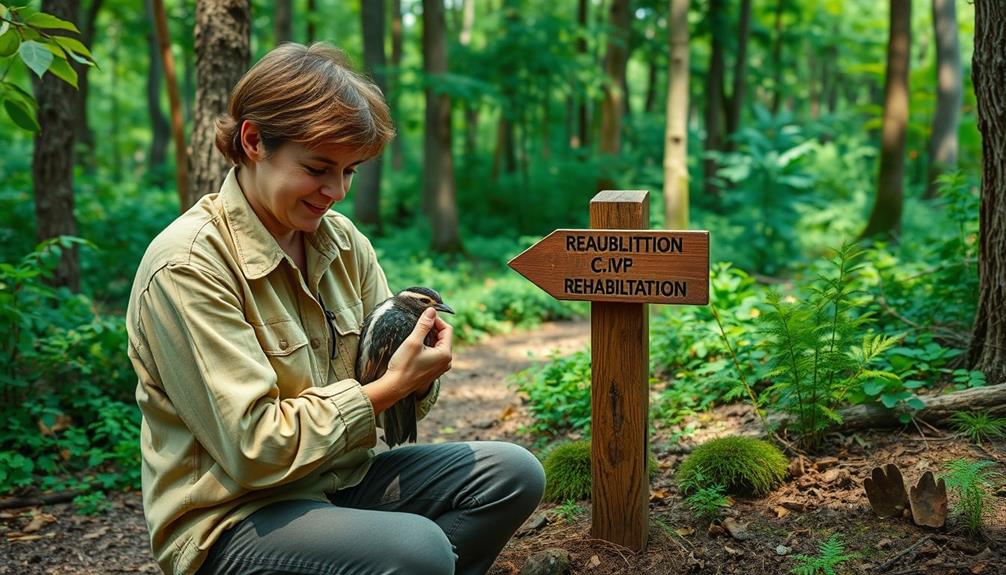You can play an essential role in wildlife rehabilitation by knowing how to help injured, sick, or orphaned animals effectively and legally. First, assess the situation to confirm the animal needs help; often, young wildlife are left temporarily by their parents. If intervention is necessary, contact a licensed rehabilitator in your area. Avoid handling wildlife without permission, as it can lead to legal issues. Cover the animal gently to reduce stress and keep pets secured. Your involvement and support can greatly assist local rehabilitators. There's plenty more to discover about assisting these animals, so keep exploring your options!
Key Takeaways
- Assess the situation carefully to determine if the animal is truly injured or orphaned before intervening.
- Contact local wildlife rehabilitators for expert guidance and assistance in caring for injured animals.
- Follow local wildlife regulations and obtain necessary permits if you plan to handle or transport wildlife.
- Minimize stress to injured animals by covering them gently and avoiding excessive handling.
- Get involved in community efforts to support wildlife rehabilitation through volunteering, donations, or educational initiatives.
Understanding Wildlife Rehabilitation
Wildlife rehabilitation is an important process that helps injured, sick, or orphaned animals recover so they can return to their natural habitats.
As you learn about this significant work, you'll find that wildlife rehabilitators play a key role in evaluating and treating injured wildlife. These dedicated individuals often operate as volunteers from their homes, relying on public donations for funding since there's typically no state support for rehabilitation expenses.
Establishing consistent routines in the rehabilitation process can provide stability for the animals and aid in their recovery, similar to how caregivers support those with BPD push-pull dynamics.
Understanding the rehabilitation process involves recognizing that it includes evaluation, treatment, recovery, and eventual release. As a licensed wildlife rehabilitator, you'd guarantee that each animal receives the appropriate care tailored to its specific needs.
It's important to observe wildlife from a distance before intervening, as many young animals may seem orphaned but are often under the watchful eye of their parents.
Identifying Orphaned or Injured Animals

When you encounter an animal that seems abandoned, it's essential to take a moment and assess the situation before jumping to conclusions. Many young wildlife species, like newborn fawns, are often left alone temporarily while their mothers forage for food. They're not necessarily orphaned.
Similarly, if you find young birds that have open eyes and feathers, they're likely healthy and don't need your help. Grounded fledglings may be learning to fly and will return to their nests when ready. Understanding the behavioral patterns of young animals can aid in distinguishing between true orphans and those simply waiting for their parents.
Also, remember that certain dog breeds with strong instincts may react differently to the presence of wildlife, so keep your pets secured during such encounters.
However, if you spot an animal that appears injured or shows distress, it's time to act. Injured animals or those exhibiting clear signs of being orphaned should be evaluated for assistance from a licensed wildlife rehabilitator.
Be cautious with grounded baby birds; don't feed or give them water without consulting an expert, as improper care can worsen their condition.
If you suspect an animal is orphaned, use a decision tree to guide your assessment. Consider factors like how long the animal has been alone and its behavior before deciding to intervene.
Legal Regulations and Permits

When it comes to wildlife rehabilitation, understanding the legal regulations and permits is essential.
You need to be aware that handling injured or sick wildlife without the proper permits can lead to serious consequences.
Additionally, familiarizing yourself with the potential tax advantages associated with rehabilitation permits can provide financial relief.
Familiarizing yourself with these requirements not only helps you stay compliant but also guarantees the ethical treatment of animals in your care.
Permitting Requirements Overview
Understanding permitting requirements is vital for anyone looking to rehabilitate injured wildlife. In Texas, you need a permit to possess or transport indigenous wildlife, so familiarize yourself with local laws to avoid legal repercussions. Only licensed rehabilitators can care for specific species listed on their permits. This guarantees they've the necessary training and resources to handle those permitted wildlife effectively.
Additionally, just as diversifying financial investments is vital for stability, guaranteeing a diverse rehabilitation approach can improve outcomes for different species in need of care, including those covered under Gold IRA Rollovers.
The Texas Parks and Wildlife Department (TPWD) strongly advises against handling injured or sick wildlife without a permit, emphasizing the importance of compliance with wildlife care regulations. Violating these rules, such as unauthorized possession or handling, can lead to serious consequences, including a Class C misdemeanor.
When seeking assistance, always check for state licensing and permits for wildlife rehabilitators. This guarantees you're working with someone authorized to provide care.
Handling Wildlife Legally
Maneuvering through the legal landscape of wildlife rehabilitation can be intimidating, but knowing the regulations helps secure both your safety and the well-being of the animals. In Texas, you need a permit to possess or transport indigenous wildlife. Familiarize yourself with local laws to avoid unintentional violations.
The Texas Parks and Wildlife Department (TPWD) strongly advises against handling injured or sick wildlife without a permit. Doing so is illegal and can lead to serious consequences. Additionally, understanding the importance of background checks before job offers can be essential for wildlife rehabilitators who are often responsible for caring for vulnerable animals.
Wildlife rehabilitators are only allowed to care for species listed on their permits, which guarantees they've the appropriate training and resources to handle specific animals. This not only protects the wildlife but also ensures that rehabilitators are equipped to provide the best care.
Remember, violating wildlife care regulations, including improper handling or possession of wildlife, can result in a Class C misdemeanor charge in Texas.
Before seeking help from any wildlife rehabilitator, make sure to check their state licensing and permits. This way, you can confirm they're operating within legal guidelines, giving you peace of mind while helping injured animals.
Consequences of Violations
Ignoring wildlife rehabilitation regulations can lead to serious consequences, both legally and ethically. In Texas, for example, you can face a Class C misdemeanor for the possession or transport of indigenous wildlife without a permit. This not only jeopardizes your ability to help injured or orphaned wildlife but also risks your legal standing.
The Texas Parks and Wildlife Department (TPWD) emphasizes that unauthorized handling of wildlife can be dangerous. You're not just breaking the law; you could also expose yourself to zoonotic diseases. Familiarizing yourself with local wildlife laws is essential to avoid these legal consequences and guarantee the safety of both yourself and the animals you aim to help.
| Action | Legal Consequence | Ethical Impact |
|---|---|---|
| Possession of wildlife without a permit | Class C misdemeanor | Hinders animal care efforts |
| Handling injured wildlife unlawfully | Possible fines and penalties | Risks animal welfare |
| Transporting wildlife illegally | Legal prosecution | Breaches trust in wildlife care |
| Caring for unpermitted species | License revocation | Undermines rehabilitation efforts |
Finding Rehabilitation Assistance

When you encounter an injured animal, finding local rehabilitation resources is essential.
It's important to understand that emotional support and compassion can greatly aid in the recovery process for wildlife, much like how emotional support through heartfelt dementia poems and tattoos helps those facing terminal illnesses.
Texas Parks and Wildlife offers a list of licensed rehabilitators by county, ensuring you can get the right help.
Local Rehabilitation Resources
How do you find the right help for injured wildlife in your area? Start by checking the Texas Parks and Wildlife (TPWD) website, which lists permitted wildlife rehabilitators by county. If your local options are limited, consider searching neighboring counties for additional resources.
Whether it's a bird with a broken wing or another wild animal in need, connecting with a rehabilitation center is essential. Additionally, understanding the importance of ethical guidelines in AI development can help you appreciate the role of technology in enhancing wildlife rescue efforts.
The National Wildlife Rehabilitation Association and Animal Help Now are excellent resources to help you locate local wildlife rescue services. They provide directories of rehabilitators who can assist injured animals. Remember, wildlife rehabilitators often operate with restricted hours, so be patient and persistent while seeking help.
It's also important to familiarize yourself with local wildlife care regulations. Possessing or transporting indigenous wildlife without the proper permits can lead to legal issues. Knowing these guidelines will guarantee that you can safely assist the injured animal while staying compliant with the law.
Contacting Wildlife Rehabilitators
Finding the right wildlife rehabilitator is vital for ensuring injured animals get the care they need. Start by visiting the Texas Parks and Wildlife (TPWD) website, where you'll find a thorough list of permitted rehabilitators by county.
Don't overlook options in adjacent counties, as they might be able to assist with your local game. Utilizing keyword clustering can also help you discover relevant resources and organizations in your area.
When you contact a rehabilitator, be patient; many work on a volunteer basis and have limited availability. During peak seasons for wildlife rescues, responses may take longer than usual, but it's worth the wait.
If you encounter a truly orphaned or injured animal, make sure to reach out to a licensed rehabilitator, as it's illegal to keep or transport indigenous wildlife without a permit in Texas.
For immediate assistance, you can call dedicated hotlines like 713-861-WILD. These professionals can provide guidance and help you determine the best course of action.
Emergency Care for Wildlife

In any situation involving injured wildlife, it's essential to stay calm and take immediate, thoughtful action. First, observe the animal from a distance to assess its condition. If you determine it's injured and in need of help, gently cover it with a towel to reduce stress, and place it in a secure, ventilated container.
It's vital to recognize that similar to how cats can exhibit stress behaviors, injured wildlife may also react negatively to excessive handling. Avoid excessive handling to prevent further harm.
Next, call your local game office or a licensed wildlife rehabilitator for guidance. Time is critical for the animal's recovery, and you'll want expert advice on the best steps to take. Remember, don't attempt to feed or give water to injured wildlife without professional instructions. For example, cow's milk can lead to dehydration in wild orphans, worsening their condition, just as high sugar content can upset a cat's digestion cat health and nutrition.
Always follow local regulations regarding wildlife handling and transport. Possessing injured wildlife without a permit can lead to legal consequences, including fines.
Importance of Community Involvement

Community involvement plays an essential role in wildlife rehabilitation, fostering a sense of shared responsibility for local ecosystems. When you engage in community participation, you help enhance public education on conservation efforts, which is critical for promoting awareness and reducing human-animal conflicts.
By participating in community-led initiatives, such as structured play events, you not only contribute to wildlife care but also encourage children to learn about the environment through play. By volunteering your time, you support rehabilitators who care for injured or orphaned wildlife, allowing them to manage their efforts more effectively.
Direct public involvement is key to the success of local wildlife organizations. They often rely on community support for fundraising events and educational programs that sustain their rehabilitation efforts. These initiatives not only raise essential funds but also educate the public about the importance of wildlife care.
Moreover, donations from the public are significant, as many rehabilitators operate on limited resources without state funding. When you advocate for wildlife-friendly practices and report injured animals, you play a pivotal role in ensuring the well-being of local wildlife populations.
Your involvement not only helps injured animals but also strengthens the community's connection to the environment. Together, we can make a lasting impact on wildlife rehabilitation efforts.
Frequently Asked Questions
How Do You Help a Wounded Animal?
When you encounter a wounded animal, first assess it from a distance. If it needs help, gently cover it, place it in a box, and contact a licensed rehabilitator for guidance. Don't provide food or water.
Is It Legal to Rehab Raccoons in Ohio?
If you find a raccoon with an injured paw, you can't just take it in. In Ohio, it's illegal to rehabilitate raccoons without a special permit, so check the laws before attempting to help.
Why Is Rehabilitation Important for Animals?
Rehabilitation's important for animals because it helps them recover from injuries, illness, or distress. By restoring their health, you enable them to return to their natural habitats, promoting biodiversity and strengthening ecosystem balance.
Is Wildlife Rehabilitation a Good Idea?
Yes, wildlife rehabilitation's a good idea. It helps injured and orphaned animals recover, increases their survival chances, and supports biodiversity. By getting involved, you can contribute to healthier ecosystems and promote responsible wildlife care in your community.
Conclusion
Wildlife rehabilitation is like a lifeline for injured animals, connecting them back to their natural world. By understanding how to identify and assist these creatures, you become a crucial part of their recovery journey. Remember, every small act counts—whether it's getting the right permits or finding local help. Together, we can create a compassionate community that nurtures our wildlife, ensuring they thrive in their habitats once again. Your involvement makes all the difference!










